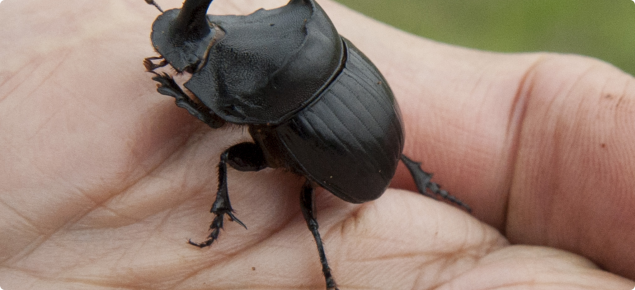Bush fly problem
WA is seasonally plagued with the exceedingly abundant and pestiferous native bush fly (Musca vetustissima). The adult flies lay eggs in fresh dung, where the larvae develop to the pupal stage.
Researchers have noted a reduction in bush fly numbers following establishment of a number of dung beetle species in the south-west. The beetles break up the cow pad within 10-30 hours, with the result that few flies survive.
The bush fly female lays its eggs on fresh droppings and the larvae (maggots) feed within the droppings, requiring high protein content in a moist, but not sloppy, matrix to maximise growth. The size reached by larvae determines the size of the resulting adult flies which do not grow further. The size of female flies is a crucial determinant of how many eggs they will lay.
Large flies lay eggs shortly after emerging and live long enough to lay many batches. Small flies take longer to lay their first eggs, lay fewer eggs per batch and do not live long enough to lay multiple batches.
Flies are not the only pests affected by the dung beetles. In both South Africa and Australia, experiments on the transmission of common helminths (intestinal worms) of cattle have shown that the activities of the beetles greatly reduce the number of infective larvae that reach the pasture from a dung pad. Pads attacked by beetles produced 48-93% fewer worm larvae than intact pads.
In the absence of dung beetles, cow pads dry out to a hard cake on the ground where they have fallen. They often remain substantially unchanged for months or even years until they finally disintegrate by weathering, rotting, trampling by stock, or termite attack. Burial of this dung by beetles means making fullest use of grazing pastures.
Dung beetle types
Introduction of dung beetles to Australia has been necessary as the native dung beetles are inefficient at breaking up the large dung pads of introduced cattle. In the south-west native beetles are active during winter, whereas the flies that breed in dung are active during summer.
Dung beetles broadly fall into two categories summer-active and winter-active. The main breeding period for most dung beetles is spring, some species have more than one generation a year.
Dung beetles are only found in fresh dung, the introduced beetles prefer cattle dung but can also be found in other types.
New adults emerge from the soil at the start of the season and seek fresh dung in which they feed for some time, often visiting several dung pads before they are ready to breed.
They pair off and commence breeding in fresh dung. Usually a male and a female will work together to build tunnels under the pad. Dung is removed from the pad and buried in balls or brood masses, depending on the species. Eggs are laid into this buried dung, As the larvae hatch they feed on the stored dung, later emerging as adults. The life cycle of the beetle varies between species from a few weeks to several months.
When feeding, adult beetles squeeze pellets of moist dung between their mouth parts and suck in the expressed juice. The beetle larvae feed on a mixture of solid particles from the dung balls in which they hatch. If they are removed from their brood balls, they are unable to survive.


